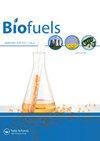Application of pharmaceutical waste as a heterogeneous catalyst for transesterification of waste cooking oil: biofuel production and its modeling using predictive tools
IF 2.6
4区 工程技术
Q3 ENERGY & FUELS
引用次数: 0
Abstract
AbstractIn this study, for the first time, pharmaceutical waste was used as a heterogeneous catalyst to produce biofuel from waste cooking oil (WCO). An efficient and low-cost heterogeneous catalyst was prepared from waste tablets of calcium carbonate (CaCO3) and magnesium oxide (MgO). A certain amount of alumina nanoparticles (Al2O3) was added to the pharmaceutical waste to participate in the transesterification of the WCO, which positively affected mass yield. The mentioned catalysts were identified by X-ray diffraction (XRD), Fourier transform infrared (FT-IR), field-emission scanning electron microscopy (FESEM), and Brunauer–Emmett–Teller (BET) analyses. According to the BET analysis, the specific surface of the catalysts increased. Also, the effects of various reaction parameters such as temperature, time, catalyst loading, and the oil: methanol ratio were investigated and optimized by response surface methodology (RSM). Furthermore, an adaptive neuro-fuzzy inference system (ANFIS) was coupled with a firefly optimization algorithm to predict biofuel yield. Under optimum conditions (Al2O3 0.952 wt%, catalyst 4.978wt%, oil:methanol ratio 0.5 vol:vol, reaction time 120 min, and reaction temperature 69.6 °C), the mass yield of MgO and CaO catalysts was 95.6 and 90.4 wt%, respectively. The composition of biofuel was identified using gas chromatography–mass spectrometry (GC-MS).Keywords: Biofuelwaste cooking oilheterogeneous catalystpharmaceutical wasteANFIS-firefly AcknowledgementsThe authors thank the authorities of the nano-laboratory of the faculty of environment for providing us with the facilities. We are also thankful to the personnel of the faculty of science at the University of Tehran for their help in GC-MS analysis. We thank the authorities of the University of Isfahan for XRD and FT-IR measurements.Disclosure statementNo potential conflict of interest was reported by the authors.医药废弃物作为废食用油酯交换多相催化剂的应用:生物燃料生产及其预测工具建模
摘要本研究首次以医药废弃物为多相催化剂,从废食用油(WCO)中制备生物燃料。以碳酸钙(CaCO3)和氧化镁(MgO)废片为原料,制备了一种高效、低成本的多相催化剂。在医药废弃物中加入一定量的氧化铝纳米颗粒(Al2O3)参与WCO的酯交换反应,对质量收率有积极影响。采用x射线衍射(XRD)、傅里叶变换红外(FT-IR)、场发射扫描电镜(FESEM)和布鲁诺尔-埃米特-泰勒(BET)分析对催化剂进行了表征。根据BET分析,催化剂的比表面积增加。采用响应面法(RSM)对温度、时间、催化剂负载、油甲醇比等不同反应参数的影响进行了研究和优化。此外,将自适应神经模糊推理系统(ANFIS)与萤火虫优化算法相结合,预测生物燃料产量。在最佳条件(Al2O3 0.952 wt%,催化剂4.978wt%,油甲醇比0.5 vol:vol,反应时间120 min,反应温度69.6℃)下,MgO和CaO催化剂的质量收率分别为95.6%和90.4 wt%。采用气相色谱-质谱联用技术(GC-MS)鉴定了生物燃料的成分。关键词:生物燃料、废食用油、多相催化剂、制药废弃物、菲斯萤火虫致谢感谢环境学院纳米实验室为我们提供的设备。我们也感谢德黑兰大学理学院的工作人员在GC-MS分析方面的帮助。我们感谢伊斯法罕大学的XRD和FT-IR测量。披露声明作者未报告潜在的利益冲突。
本文章由计算机程序翻译,如有差异,请以英文原文为准。
求助全文
约1分钟内获得全文
求助全文
来源期刊

Biofuels-Uk
Energy-Renewable Energy, Sustainability and the Environment
CiteScore
5.40
自引率
9.50%
发文量
56
期刊介绍:
Current energy systems need a vast transformation to meet the key demands of the 21st century: reduced environmental impact, economic viability and efficiency. An essential part of this energy revolution is bioenergy.
The movement towards widespread implementation of first generation biofuels is still in its infancy, requiring continued evaluation and improvement to be fully realised. Problems with current bioenergy strategies, for example competition over land use for food crops, do not yet have satisfactory solutions. The second generation of biofuels, based around cellulosic ethanol, are now in development and are opening up new possibilities for future energy generation. Recent advances in genetics have pioneered research into designer fuels and sources such as algae have been revealed as untapped bioenergy resources.
As global energy requirements change and grow, it is crucial that all aspects of the bioenergy production process are streamlined and improved, from the design of more efficient biorefineries to research into biohydrogen as an energy carrier. Current energy infrastructures need to be adapted and changed to fulfil the promises of biomass for power generation.
Biofuels provides a forum for all stakeholders in the bioenergy sector, featuring review articles, original research, commentaries, news, research and development spotlights, interviews with key opinion leaders and much more, with a view to establishing an international community of bioenergy communication.
As biofuel research continues at an unprecedented rate, the development of new feedstocks and improvements in bioenergy production processes provide the key to the transformation of biomass into a global energy resource. With the twin threats of climate change and depleted fossil fuel reserves looming, it is vitally important that research communities are mobilized to fully realize the potential of bioenergy.
 求助内容:
求助内容: 应助结果提醒方式:
应助结果提醒方式:


